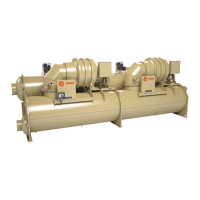44
CDHH-SVX003C-EN
Insulation
Unit Insulation Requirements
Factory-installed insulation is available as an option for all
units. Factory installation does NOT include insulation of
the chiller feet; if required, insulation for chiller feet is
provided by others. In applications where the chiller is not
factory-insulated, install insulation over the areas outlined
and highlighted with dashed lines as shown in the figure in
“Factory-applied Insulation,” p. 44.
The quantities of insulation required based on unit size and
insulation thickness are listed in the following table.
Insulation thickness is determined at normal design
conditions which are:
• Standard comfort-cooling leaving chilled water
temperature
• 85°F (29.4°C) dry bulb ambient temperature
• 75 percent relative humidity
Operation outside of normal design conditions as defined in
this section may require additional insulation; contact Trane
for further review.
Note: If the unit is not factory-insulated, install insulation
around the evaporator bulbwells and ensure that the
bulbwells and connections for the waterbox drains
and vents are still accessible after insulation is
applied. The sensor modules (Low Level Intelligent
Devices [LLIDs]) and interconnecting four-wire cable
inter-processor communication (IPC) bus must be
raised up above the field-installed insulation. Secure
the IPC bus to the insulation top/outer surface after
insulation is completed.
Important: Do NOT insulate the motor housing, unit wiring,
or sensor modules.
WARNING
Replace Manual in Cabinet After Use!
Failure to replace this Installation, Operation, and
Maintenance manual in cabinet after use could
prevent personnel from accessing necessary safety
information and could result in death or serious injury
or equipment damage.
NOTICE
Equipment Damage!
Failure to remove the strain relief with the sensor
could result in equipment damage.
Do NOT attempt to pull sensor bulb through the strain
relief; always remove the entire strain relief with the
sensor.
Table 15. Evaporator insulation requirements
EVSZ (Standard Unit)
3/4 in. (19.05 mm) Insulation
Square Feet Square Meters
400M 1285 119.4
440M 1338 124.3
440X 1408 130.8
Notes:
1. Units are NOT insulated on the motor or refrigerant drain lines.
2. 3/4-in. (19.05-mm) sheet insulation is installed on the evaporator,
evaporator waterboxes, suction elbow, suction cover, economizer, liquid
lines, and piping.
3. Copper oil eductor lines require pipe insulation.
Insulation Thickness
Requirements
Factory-applied Insulation
All low-temperature surfaces are covered with 3/4 in.
(19.05 mm) Armaflex® II or equal (thermal conductivity =
0.25 Btu/h-ft
2
[0.036 W/m
2
- K]), evaporator, waterboxes,
suction elbow, economizer, and piping.
The insulation is Armaflex® or equivalent closed cell
elastomeric insulation to prevent the formation of
condensation in environments with a relative humidity up to
75 percent. Chillers in high humidity areas or ice storage,
low leaving water temperature (less than 36°F [2.2°C]
chilled water temperature/glycol) units, may require double
thickness to prevent formation of condensation.
NOTICE
Insulation Damage!
Failure to follow these instructions could result in
insulation damage.
To prevent damage to factory installed insulation:
• Do not allow the insulation to be exposed to
excessive sunlight. Store indoors or cover with
canvas to prevent exposure.
• Do not use thinners and solvents or other types of
paint. Use only water base latex.

